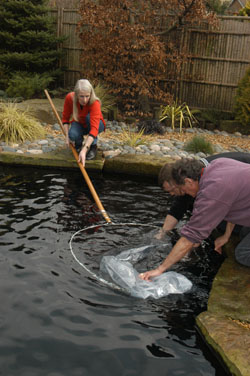There are several items of equipment as well as some important chemicals and other accessories required if one is to keep Nishikigoi successfully today and I will detail all of these in this part of my website. Before I continue, I am assuming that you already have a good pond system together with your own collection of Koi.
If, on the other hand, you are planning to keep Koi in the near future then this text may also be of assistance as to the vital items you will actually require at a later date.
Koi handling equipment.
a. A suitable plastic circular Koi inspection bowl.
This is an important item as your Koi will have to be placed in this bowl, after careful netting, for general routine inspection or medication. It is also required if you need to place your Koi in bags before transporting them to a show. Please bear in mind that your bowl should be easily large enough to accommodate your biggest Koi comfortably without causing discomfort. In view of this and the fact that Koi can grow quite quickly over the years I would suggest that, the larger the better, is your best choice for this piece of equipment. Koi bowls are manufactured in the UK from blue-pigmented plastic in many sizes and some can be sturdy enough to cope with your requirements quite satisfactorily. These UK made bowls are offered for sale at many Koi outlets but the more-expensive ‘hard to find ones’ are imported from Japan and are far superior in terms of build quality and longevity.
Do not fall into the trap of buying the shallow, rectangular ‘Japanese Basket with a lid’ sometimes offered for sale in the UK as these were only made for general live fish auctions in Japan – generally Magoi and eels. They can sometimes produce damage to the anal fin if it gets caught in the slits on the base of the basket.
Before you actually purchase your bowl, do check via the internet or by classified ads in Koi magazines for enthusiasts who may be leaving the hobby and have items such as this for sale at greatly reduced prices. A good second-hand bowl that is cleaned out thoroughly is just as good as the new item.
b. A very good, purpose-made Koi Net.
 Angler’s landing nets are of no use whatsoever for this task and will cause serious damages to your Koi if employed to this end.
Angler’s landing nets are of no use whatsoever for this task and will cause serious damages to your Koi if employed to this end.
There are some manufacturers in the UK who make and supply Koi nets, in various sizes of pole and net diameter, to Koi dealers for re-sale. These nets are usually supplied with hollow aluminium poles with moveable rubber handgrips but I have always found these nets to be difficult to manoeuvre, particularly when attempting to net Koi in smaller sizes.
By far, the best Koi nets available are the special wooden-handled, shallow ones imported from Japan and widely used by the Japanese Koi breeders. Unfortunately the sea-freight and importation costs make these nets far more expensive than the ones produced in the UK.
Again, there are many excellent Japanese second-hand Koi nets that can be found for sale at very reduced prices. Please also be very aware that Koi nets are only intended to ‘guide and coax’ the Koi into a bowl – at no time should they ever be used to lift the Koi out of the water.
Good netting techniques come by patience and experience.
c. Koi Handling or Lifting Nets.
 These are also referred to as ‘Socks’ at some outlets and, in my own experiences, are not really necessary at all as long as one has a double-strength vinyl bag to handle the work of transferring a Koi from the ‘bowl’ of a shallow Koi net into the plastic bowl by slipping the bag underneath the head of the Koi.
These are also referred to as ‘Socks’ at some outlets and, in my own experiences, are not really necessary at all as long as one has a double-strength vinyl bag to handle the work of transferring a Koi from the ‘bowl’ of a shallow Koi net into the plastic bowl by slipping the bag underneath the head of the Koi.
Many Japanese Koi breeders refuse to use these ‘lifting nets’ because of potential damage that can result. My advice is to use the good old vinyl bag instead, it’s far cheaper and far safer!



